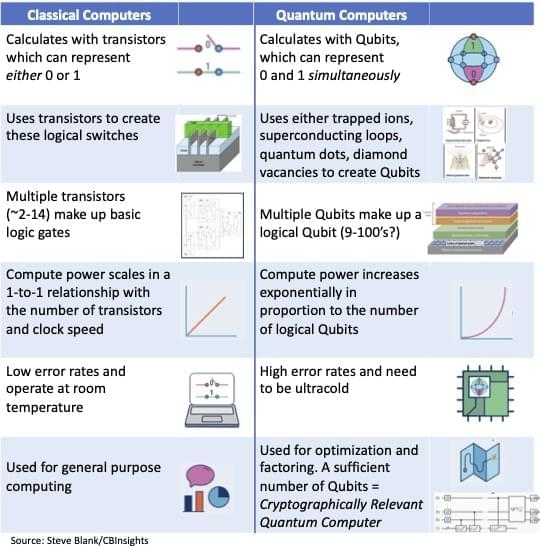Mar 23, 2022
The Quantum Technology Ecosystem — Explained
Posted by Jose Ruben Rodriguez Fuentes in categories: business, quantum physics
If you think you understand quantum mechanics, you don’t understand quantum mechanics
Richard Feynman

If you think you understand quantum mechanics, you don’t understand quantum mechanics
Richard Feynman
Surgically placed electrodes enable person with late-stage ALS to communicate via neural signals.
Extension of laser beam structures promises new laser applications. Exploration of how beam structures change during nonlinear frequency conversion processes has drawn increasing interest in recent years. Nonlinear conversion is an excellent route for structured beam generation and represents a growing, hybrid field for researchers in nonlinear optics and laser technology, as well as the emerging area of light-field regulation technology.
For structured beam generation and nonlinear frequency conversion, researchers have considered both intracavity oscillation and external cavity spatial modulation. To achieve flexible outputs, spatial light modulators can be used to obtain structured beams both inside and outside the laser cavity. But this is an indirect, inefficient method. Intracavity nonlinear frequency generation of structured beams offers a direct, efficient method that has only rarely been investigated, until recently.
Inside a laser cavity, an effect known as “transverse mode locking” (TML) enables the direct generation of the vortex beams or optical vortices from a laser cavity. It is known that both solid-state microchip lasers and VCSELs can produce quite similar outputs of TML beam patterns under large Fresnel number pumping conditions. The complex transverse patterns formed by the TML effect, commonly composed of different basic modes with different weight coefficients and different locking phases, make for abundant spatial information in fundamental frequency modes. Nonlinear frequency conversion of these directly generated TML beams is of great interest, but not yet well studied.
The creation of new proteins and peptides for use with CRISPR represents the next stage in the evolution of this technology.
SpaceX’s Starlink satellite internet kit is going up from $499 to $549 for waiting deposit holders, and to $599 for new customers.
𝙇𝙤𝙪 𝙂𝙚𝙝𝙧𝙞𝙜’𝙨 𝙙𝙞𝙨𝙚𝙖𝙨𝙚—𝙖𝙢𝙮𝙤𝙩𝙧𝙤𝙥𝙝𝙞𝙘 𝙡𝙖𝙩𝙚𝙧𝙖𝙡 𝙨𝙘𝙡𝙚𝙧𝙤𝙨𝙞𝙨 (𝘼𝙇𝙎)—𝙞𝙨 𝙖 𝙣𝙞𝙜𝙝𝙩𝙢𝙖𝙧𝙚 𝙞𝙣 𝙞𝙩𝙨 𝙖𝙙𝙫𝙖𝙣𝙘𝙚𝙙 𝙛𝙤𝙧𝙢, 𝙡𝙚𝙖𝙫𝙞𝙣𝙜 𝙥𝙖𝙩𝙞𝙚𝙣𝙩𝙨 𝙬𝙞𝙩𝙝𝙤𝙪𝙩 𝙖𝙣𝙮 𝙢𝙚𝙖𝙣𝙨 𝙤𝙛 𝙘𝙤𝙢𝙢𝙪𝙣𝙞𝙘𝙖𝙩𝙞𝙣𝙜 𝙩𝙝𝙚𝙞𝙧 𝙣𝙚𝙚𝙙𝙨 𝙖𝙣𝙙 𝙬𝙞𝙨𝙝𝙚𝙨. 𝘽𝙪𝙩 𝙖 𝙣𝙚𝙬 𝙗𝙧𝙖𝙞𝙣 𝙞𝙢𝙥𝙡𝙖𝙣𝙩 𝙝𝙖𝙨 𝙖𝙡𝙡𝙤𝙬𝙚𝙙 𝙖 34-𝙮𝙚𝙖𝙧-𝙤𝙡𝙙 𝙡𝙤𝙘𝙠𝙚𝙙-𝙞𝙣 𝘼𝙇𝙎 𝙥𝙖𝙩𝙞𝙚𝙣𝙩 𝙩𝙤 𝙧𝙚𝙜𝙖𝙞𝙣 𝙝𝙞𝙨 𝙖𝙗𝙞𝙡𝙞𝙩𝙮 𝙩𝙤 𝙘𝙤𝙢𝙢𝙪𝙣𝙞𝙘𝙖𝙩𝙚 𝙬𝙞𝙩𝙝 𝙛𝙖𝙢𝙞𝙡𝙮 𝙖𝙣… See more.
The Neuro-Network.
𝐁𝐫𝐚𝐢𝐧 𝐢𝐦𝐩𝐥𝐚𝐧𝐭 𝐡𝐞𝐥𝐩𝐬 𝐜𝐨𝐦𝐩𝐥𝐞𝐭𝐞𝐥𝐲 ‘𝐥𝐨𝐜𝐤𝐞𝐝-𝐢𝐧’ 𝐦𝐚𝐧 𝐜𝐨𝐦𝐦𝐮𝐧𝐢𝐜𝐚𝐭𝐞
Continue reading “Brain implant helps completely ‘locked-in’ man communicate” »
Al Sandrock, the top scientist at Biogen who exited last year in a dispute over its controversial Alzheimer’s treatment, has landed a new job as the CEO of Voyager Therapeutics, the company said Tuesday.
Voyager’s appointment of Sandrock as its new CEO is the latest in a series of moves aimed at refocusing the company on a new gene therapy delivery technology, following setbacks with its earlier pipeline.
Kinova, a Canadian company that specializes in robotic arms, is launching Link 6, a new generation industrial robot designed for all businesses looking to benefit from automation.
The Link 6 collaborative robot features automation solutions that enable greater daily efficiency while improving the quality and consistency of production results. Kinova’s newest robot helps you start producing faster thanks to a rich interface on its wrist, feed-through of power and data, optional Gigabit Ethernet adapter, and optional wrist vision module.
The company says its Link 6 controller provides the highest processing power and memory capacity on the market, making it ready to use with the AI solutions of the future while keeping the size of the controller compact. Link 6 robotic arm is developed and designed with any user in mind: an experienced industrial integrator and an operator with no particular robotic skills.
Did they purposely set out to create inventions that will bring death and blood shed?🤔
Usually when drafting a Patent Claim for any invention, the Inventor states the benefits of the invention to the society.
Looking at the picture below i am tempted to ask, of what use are Nuclear bombs and other weapons of mass destruction of benefit to the society?
There’s a gap on the electromagnetic spectrum where engineers can not tread.
The spectrum covers everything from radio waves and microwaves, to the light that reaches our eyes, to X-rays and gamma rays. And humans have mastered the art of sending and receiving almost all of them.
There is an exception, however. Between the beams of visible light and the blips of radio static, there lies a dead zone where our technology isn’t effective. It’s called the terahertz gap. For decades now, no one’s succeeded in building a consumer device that can transmit terahertz waves.
Continue reading “You’ve probably never heard of terahertz waves, but they could change your life” »
